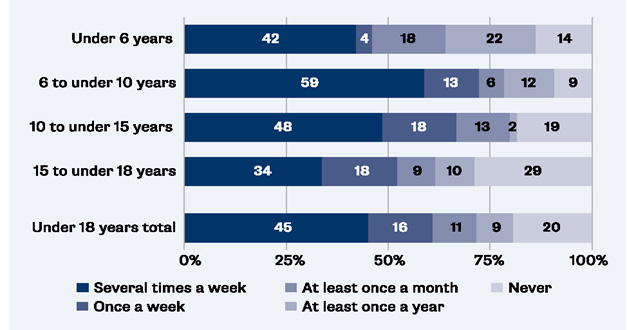|

|
FAMILIES IN AUSTRIA
PARTNERSHIPS, FERTILITY INTENTIONS AND ECONOMIC SITUATION
IN CHALLENGING TIMES
Editorial team: Norbert Neuwirth,
Isabella Buber-Ennser, Beat Fux
University of Vienna, 2023, 82 pages
|
https://www.ggp-austria.at/fileadmin/user_upload/k_ggp_austria/GGPat_Families_in_Austria_2023.pdf
|

Как часто разлученные отцы присматривают за своими детьми?
(%) (стр. 22)

Идеальное количество детей в семье в Австрии (%)
(стр. 31)

Намерения в отношении рождения детей (%) (стр.
37)

Доля респондентов в возрасте 15-49 лет, когда-либо
прибегавших к лечению бесплодия, по возрасту и полу (%) (стр.
39)

Намерение переехать по количеству детей (%) (стр.
61)
|
В отчете представлены самые последние данные о семьях
в Австрии, основанные на данных исследования "Поколения и гендер"
(Generations & Gender Survey).
Как и во всех участвующих в исследовании странах, выборка
для текущего раунда опроса (GGP-II) была составлена заново, но анкеты
сопоставимы с теми, которые использовались в первом опросе. Это
означает, что изменения в жизненных обстоятельствах изучаемых когорт
можно отследить наилучшим образом.
Были опрошены респонденты в возрасте 18-59 лет на отчетную
дату в середине сентября 2022 года. Краткие результаты, содержащиеся
в данной публикации, основаны на проверенных и скорректированных
данных. Они представляют подробную информацию о намерениях по рождению
детей, рождаемости, формах партнерства, конфликтном потенциале и
стабильности отношений пар, их соответствующих связях с участием
в рабочей силе, внутрисемейным разделением труда, межпоколенческих
связях, семейных структурах и другим аспектам.
Contents
Introduction
1 The international Generations and Gender Programme
2 GGP.at - the Generations and Gender Programme in Austria
3 Cohort fertility and parity distribution
Family and Partnership
4 Where do couples meet?
5 Couples in Austria: birds of a feather flock together
6 Partnership status and marriage plans
7 Living Apart Together - couple relationships across household
boundaries
8 Same-sex couples
9 Partnership satisfaction and conflicts
10 The beginning of the end? Couples thinking about breaking up
11 Partnerships and migration background
12 Partnership trajectories
13 Education and women's age at first birth
14 Biological children, stepchildren, adopted and foster children
15 Who do minors live with?
16 Father-child relationship after parental separation
17 Upward intergenerational mobility in education in Austria
18 Young adults living with their parents
19 Families and household types
20 Aspects of intergenerational relations
Fertility Intentions
21 Are children important for a fulfilled life?
22 Women's fertility intentions and number of children by formal
education
23 One, two or three? On the ideal number of children
24 Two-child ideal and migration background
25 Religion and number of children
26 Uncertainties in fertility intentions
27 Childlessness: voluntary or involuntary?
28 Only children and childbearing intentions
29 (Un)planned parenthood
30 Fertility intentions by age: childless vs. parents
31 Experiencing infertility
32 Assisted reproduction: prevalence among men and women
33 Childbearing intentions and number of children: 2009 and 2023
- a comparison
Families as High Performers
34 Paid work in a couple context
35 Employment status of working-age couples
36 The work-life balancing act
37 Working during off-peak hours and at weekends
38 Working from home and stress levels
39 Who decides on the amount of paid work?
40 How many hours a week should fathers and mothers work?
41 Do children suffer if their mothers work?
42 Attitudes towards gender equality in education and (unpaid)
work
43 Division of household tasks
44 Who is responsible for childcare tasks in couple households?
45 Satisfaction with the division of housework and childcare
46 Are women or men better at caring for small children?
47 Organisation of childcare and the importance of informal support
services
48 Division of unpaid work: a comparison over time
Economic Situation and Wellbeing
49 The financial situation of families
50 Intra-family transfers - about receiving and giving
51 Housing status and financial situation
52 Intentions to move and emigrate
53 A sense of social inclusion
54 Health snapshot and some challenges
55 Children and life satisfaction
56 Psychological wellbeing: risk of depression
57 Life course stress: manifestations in diverse domains
58 Health-related stress, family and caring responsibilities
59 The prevalence of health-related stress in social groups
60 Happiness and social networks by country of birth
61 Do children reduce adults' online time?
Crises and Impacts
62 Effects of multiple crises
63 How do families cope with inflation?
64 The impact of crises: what do families expect?
65 Making ends meet
66 Is the change in fertility intentions due to the global crises?
Addendum
List of sources
List of authors
|

